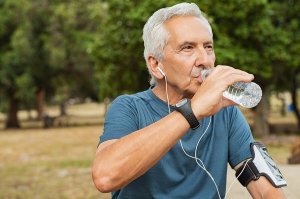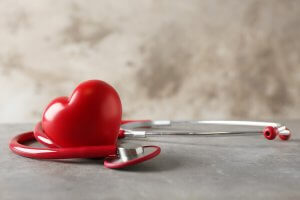Exercise Against Heart Disease

Heart disease is one of the deadliest diseases in the western world and it happens with age. However, there are other cases that occur in young patients and athletes that are genetic. In this article, we’ll see the most common heart diseases and how exercise can help prevent its appearance and progression.
Heart diseases
Heart or cardiovascular diseases are those that affect the heart or blood vessels. As we mentioned, they can be very deadly in the western population. There are a few groups:
- Acute coronary syndrome: these diseases have less blood circulation. Generally, they can lead to changes in the walls of the heart, which will eventually lead to heart failure. For example, this includes acute heart attacks and angina pectoris, both exertion and stable angina.
- Valvular heart disease: this can be genetic or from previous heart injuries. Generally, this can happen after a heart attack.
- Genetic conditions that affect young patients and athletes. In fact, these can be arrhythmic syndromes such as Wolf-Parkinson-White or Brugada syndrome. Also, they can be structural diseases such as hypertrophic cardiomyopathy or arrhythmogenic dysplasia.

Sports and heart disease
Sports are great to keep us healthy. We already know that playing sport benefits the cardiovascular system. However, when we talk about preexisting conditions, researchers don’t agree about whether or not it’s good to play sports.
Section by section, we’ll talk about the possible benefits of playing sports in each type of heart disease that we mentioned.
Sports and acute coronary syndrome
Acute coronary syndrome is a group of heart diseases connected with age. As you become older, cholesterol-derived substances build up in the walls of your arteries.
These deposits make up the atheroma plaques, which can rupture and damage the coronary artery. If this happens, part of the heart stops receiving blood. Then, you could suffer a heart attack.
However, because of certain genetics, these heart attacks can occur in younger patients too, such as Iker Casillas, a Spanish goalie.
You should avoid exercising for a few months after a heart attack so that the tissue can heal. However, afterward, doctors recommend exercising regularly to improve heart function. In addition, you can prevent heart failure.
Sports and valvular heart disease
Valvular heart diseases can be very different from each other. This is because they’re caused by structural changes caused by heart attacks. In fact, these heart attacks can happen because of age, genetics, or even high blood pressure over time.

We recommend exercise as long as it won’t trigger a major problem, such as heart attacks or arrhythmia. For this, make sure you talk with your cardiologist. He will decide whether physical exercise is beneficial or harmful.
Sports in genetic heart disease
Genetic diseases such as arrhythmogenic dysplasia or Brugada syndrome can be dangerous. This is because they usually don’t have a lot of symptoms, so people don’t notice them. When you exercise, you work your cardiovascular system, which can cause sudden death due to ventricular failure.
Ultimately, other diseases such as cardiomyopathies can be more progressive. Therefore, exercise is a key tool to delay its progression and improve symptoms.
Heart disease is one of the deadliest diseases in the western world and it happens with age. However, there are other cases that occur in young patients and athletes that are genetic. In this article, we’ll see the most common heart diseases and how exercise can help prevent its appearance and progression.
Heart diseases
Heart or cardiovascular diseases are those that affect the heart or blood vessels. As we mentioned, they can be very deadly in the western population. There are a few groups:
- Acute coronary syndrome: these diseases have less blood circulation. Generally, they can lead to changes in the walls of the heart, which will eventually lead to heart failure. For example, this includes acute heart attacks and angina pectoris, both exertion and stable angina.
- Valvular heart disease: this can be genetic or from previous heart injuries. Generally, this can happen after a heart attack.
- Genetic conditions that affect young patients and athletes. In fact, these can be arrhythmic syndromes such as Wolf-Parkinson-White or Brugada syndrome. Also, they can be structural diseases such as hypertrophic cardiomyopathy or arrhythmogenic dysplasia.

Sports and heart disease
Sports are great to keep us healthy. We already know that playing sport benefits the cardiovascular system. However, when we talk about preexisting conditions, researchers don’t agree about whether or not it’s good to play sports.
Section by section, we’ll talk about the possible benefits of playing sports in each type of heart disease that we mentioned.
Sports and acute coronary syndrome
Acute coronary syndrome is a group of heart diseases connected with age. As you become older, cholesterol-derived substances build up in the walls of your arteries.
These deposits make up the atheroma plaques, which can rupture and damage the coronary artery. If this happens, part of the heart stops receiving blood. Then, you could suffer a heart attack.
However, because of certain genetics, these heart attacks can occur in younger patients too, such as Iker Casillas, a Spanish goalie.
You should avoid exercising for a few months after a heart attack so that the tissue can heal. However, afterward, doctors recommend exercising regularly to improve heart function. In addition, you can prevent heart failure.
Sports and valvular heart disease
Valvular heart diseases can be very different from each other. This is because they’re caused by structural changes caused by heart attacks. In fact, these heart attacks can happen because of age, genetics, or even high blood pressure over time.

We recommend exercise as long as it won’t trigger a major problem, such as heart attacks or arrhythmia. For this, make sure you talk with your cardiologist. He will decide whether physical exercise is beneficial or harmful.
Sports in genetic heart disease
Genetic diseases such as arrhythmogenic dysplasia or Brugada syndrome can be dangerous. This is because they usually don’t have a lot of symptoms, so people don’t notice them. When you exercise, you work your cardiovascular system, which can cause sudden death due to ventricular failure.
Ultimately, other diseases such as cardiomyopathies can be more progressive. Therefore, exercise is a key tool to delay its progression and improve symptoms.
All cited sources were thoroughly reviewed by our team to ensure their quality, reliability, currency, and validity. The bibliography of this article was considered reliable and of academic or scientific accuracy.
- Najari F, Alimohammadi A, Ghodrati P. Sudden Death Following Exercise; a Case Series. Emerg (Tehran, Iran) [Internet]. 2016 [cited 2019 Oct 12];4(2):97–100. Available from: http://www.ncbi.nlm.nih.gov/pubmed/27274521
- Bove AA. Exercise and Heart Disease. Methodist Debakey Cardiovasc J [Internet]. 2016 [cited 2019 Oct 12];12(2):74–5. Available from: http://www.ncbi.nlm.nih.gov/pubmed/27486487
- Soares-Miranda L, Siscovick DS, Psaty BM, Longstreth W, Jr, Mozaffarian D. Physical Activity and Risk of Coronary Heart Disease and Stroke in Older Adults: The Cardiovascular Health Study. Circulation [Internet]. 2016 Jan 12 [cited 2019 Oct 12];133(2):147. Available from: http://www.ncbi.nlm.nih.gov/pubmed/26538582
This text is provided for informational purposes only and does not replace consultation with a professional. If in doubt, consult your specialist.








